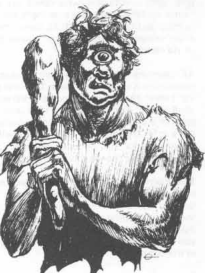BX Monsters A to Z: Cyclops

Straight out of the Expert Rules by way of Greek mythology, today's monster is the mighty cyclops. I shall call him Blinky. Or maybe Winky. The cyclops is described as a rare type of giant, but apparently is sufficiently different enough from "true' giants to merit a separate listing in the monster section. Its optical oddity is certainly unlike all other giants, and it also isn't classified according to preferred terrain/elemental affinity as the others are. It is, however, pretty closely aligned with the stats for other giants, with a slightly inferior Armor Class (5, compared to most other giants' 4) and 13 Hit Dice, which puts it roughly on par with the cloud giant. Both are listed as being about 20 feet in height, so a rare mark for consistency in monster stats to Cook and Marsh. It's a bit more ponderous in its movement than other giants, at 90'(30') to their 120'(40'); let's chalk that up to its poor depth perception. It can still
